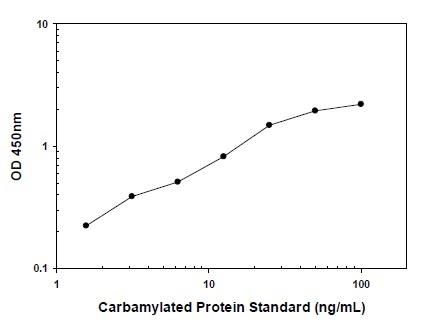anti-Notch 2 antibody [HMN2-35]
CAT.NO. : ARG23293
US$ Please choose
US$ Please choose
Size:
Trail, Bulk size or Custom requests Please contact us
*产品价格可能会有所调整,请以品牌方官网实时更新的价格为准,以确保准确性。
概述
| 产品描述 | Hamster Monoclonal antibody [HMN2-35] recognizes Notch 2 |
|---|---|
| 反应物种 | Ms, Rat |
| 应用 | FACS |
| 宿主 | Hamster |
| 克隆 | Monoclonal |
| 克隆号 | HMN2-35 |
| 同位型 | IgG |
| 靶点名称 | Notch 2 |
| 抗原物种 | Mouse |
| 抗原 | Mouse Notch 2-Fc fusion protein. |
| 偶联标记 | Un-conjugated |
| 別名 | N2ICD; HJCYS; AGS2; N2ECD; hN2; Neurogenic locus notch homolog protein 2; Notch 2 |
应用说明
| 应用建议 |
| ||||
|---|---|---|---|---|---|
| 应用说明 | FACS: Use 10 µl of the suggested working dilution to label 10^6 cells in 100 µl. * The dilutions indicate recommended starting dilutions and the optimal dilutions or concentrations should be determined by the scientist. |
属性
| 形式 | Liquid |
|---|---|
| 纯化 | Purification with Protein G. |
| 缓冲液 | PBS and 0.09% Sodium azide. |
| 抗菌剂 | 0.09% Sodium azide |
| 浓度 | 1 mg/ml |
| 存放说明 | For continuous use, store undiluted antibody at 2-8°C for up to a week. For long-term storage, aliquot and store at -20°C or below. Storage in frost free freezers is not recommended. Avoid repeated freeze/thaw cycles. Suggest spin the vial prior to opening. The antibody solution should be gently mixed before use. |
| 注意事项 | For laboratory research only, not for drug, diagnostic or other use. |
生物信息
| 数据库连接 | Swiss-port # O35516 Mouse Neurogenic locus notch homolog protein 2 |
|---|---|
| 基因名称 | NOTCH2 |
| 全名 | notch 2 |
| 背景介绍 | This gene encodes a member of the Notch family. Members of this Type 1 transmembrane protein family share structural characteristics including an extracellular domain consisting of multiple epidermal growth factor-like (EGF) repeats, and an intracellular domain consisting of multiple, different domain types. Notch family members play a role in a variety of developmental processes by controlling cell fate decisions. The Notch signaling network is an evolutionarily conserved intercellular signaling pathway which regulates interactions between physically adjacent cells. In Drosophilia, notch interaction with its cell-bound ligands (delta, serrate) establishes an intercellular signaling pathway that plays a key role in development. Homologues of the notch-ligands have also been identified in human, but precise interactions between these ligands and the human notch homologues remain to be determined. This protein is cleaved in the trans-Golgi network, and presented on the cell surface as a heterodimer. This protein functions as a receptor for membrane bound ligands, and may play a role in vascular, renal and hepatic development. Two transcript variants encoding different isoforms have been found for this gene. [provided by RefSeq, Jan 2011] |
| 生物功能 | Functions as a receptor for membrane-bound ligands Jagged1, Jagged2 and Delta1 to regulate cell-fate determination. Upon ligand activation through the released notch intracellular domain (NICD) it forms a transcriptional activator complex with RBPJ/RBPSUH and activates genes of the enhancer of split locus. Affects the implementation of differentiation, proliferation and apoptotic programs (By similarity). Involved in bone remodeling and homeostasis. In collaboration with RELA/p65 enhances NFATc1 promoter activity and positively regulates RANKL-induced osteoclast differentiation. Positively regulates self-renewal of liver cancer cells. [UniProt] |
| 预测分子量 | 265 kDa |
| 翻译后修饰 | Synthesized in the endoplasmic reticulum as an inactive form which is proteolytically cleaved by a furin-like convertase in the trans-Golgi network before it reaches the plasma membrane to yield an active, ligand-accessible form. Cleavage results in a C-terminal fragment N(TM) and a N-terminal fragment N(EC). Following ligand binding, it is cleaved by TNF-alpha converting enzyme (TACE) to yield a membrane-associated intermediate fragment called notch extracellular truncation (NEXT). This fragment is then cleaved by presenilin dependent gamma-secretase to release a notch-derived peptide containing the intracellular domain (NICD) from the membrane (By similarity). Hydroxylated by HIF1AN. Can be either O-glucosylated or O-xylosylated at Ser-613 by POGLUT1. [UniProt] |
 New Products
New Products




![anti-Notch 2 antibody [HMN2-35]](/upload/image/products/ARG23293_FACS_1_210_205.jpg)
![anti-Notch 2 antibody [HMN2-35]](/upload/image/products/ARG23293_FACS_1.jpg)












